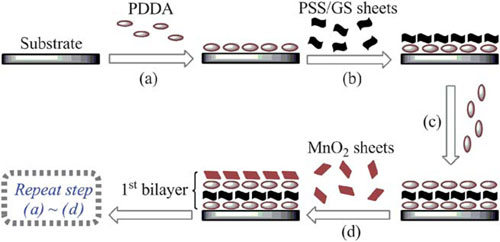Supercapacitors are a new kind of electrochemical energy storage systems different from conventional capacitors or batteries. They are environmental friendly and possess the properties of pulse power supply, long cycle life, high dynamic of charge propagation and wide range of working temperature. The key part of supercapacitors is electrodes with excellent performance.
As a novel two-dimensional carbon material, graphene sheet (GS) shows good conductivity, mechanical stiffness, good flexibility and high surface area. It is expected that GS may be applied widely as supercapacitors electrodes in the future. However, the lack of functional groups on pure graphene surface makes it difficult for graphene to be combined with other materials or assembled on devices, which hinders the application of graphene. Therefore, the research on chemical modification of graphene surface to obtain various functional composite materials is quite significant.
Researchers of the State Key Laboratory of the Solid Lubrication of the Lanzhou Institute of Chemical Physics (LICP), CAS, have fabricated flexible graphene sheet (GS)/polyaniline (PANi) nanofibers composite paper (see Fig.1). It is prepared via a facile and fast two-step route composed of electrostatic adsorption between negatively-charged poly(sodium 4-styrenesulfonate) (PSS) mediated GS (coded as PSS-GS) and positively-charged PANi nanofibers and the follow-up vacuum filtration of the as-prepared PSS-GS/PANi nanofibers suspension. In addition, they also constructed a new class of multilayer films (see Fig.2)by electrostatic layer-by-layer self-assembly technique, using PSS-GS, manganese dioxide (MnO2) sheets, and poly(diallyldimethylammonium) (PDDA) as building blocks.

Fig.1 Left: digital camera images (left) of PANi nanofibers colloid solution, PSS-GS dispersion and PSS-GS/PANi dispersion at different reaction time; middle: the free-standing PSS-GS paper (a) and (d), PSS-GS/PANi paper (b: 5%, c and e: 10%); right: illustration of electrostatic adsorption between negatively-charged PSS-GS and positively-charged PANi molecules. (Image by WANG Jinqing et al.)

Fig. 2 A schematic view for constructing multilayer films on substrate.(Image by WANG Jinqing et al.)
Electrochemical performance tests show that both the PSS-GS/PANi composite paper and multilayer film electrode exhibit high specific capacitance and excellent cycle life performance.
The work has received support from the National Natural Science Foundation of China. The finds have been published in New J. Chem.(2011, 35, 369–374) and J. Mater. Chem. (2011, 21, 3397–3403).
New J. Chem.Paper
J. Mater. Chem.Paper
Prof. WANG Jinqing's Homepage

